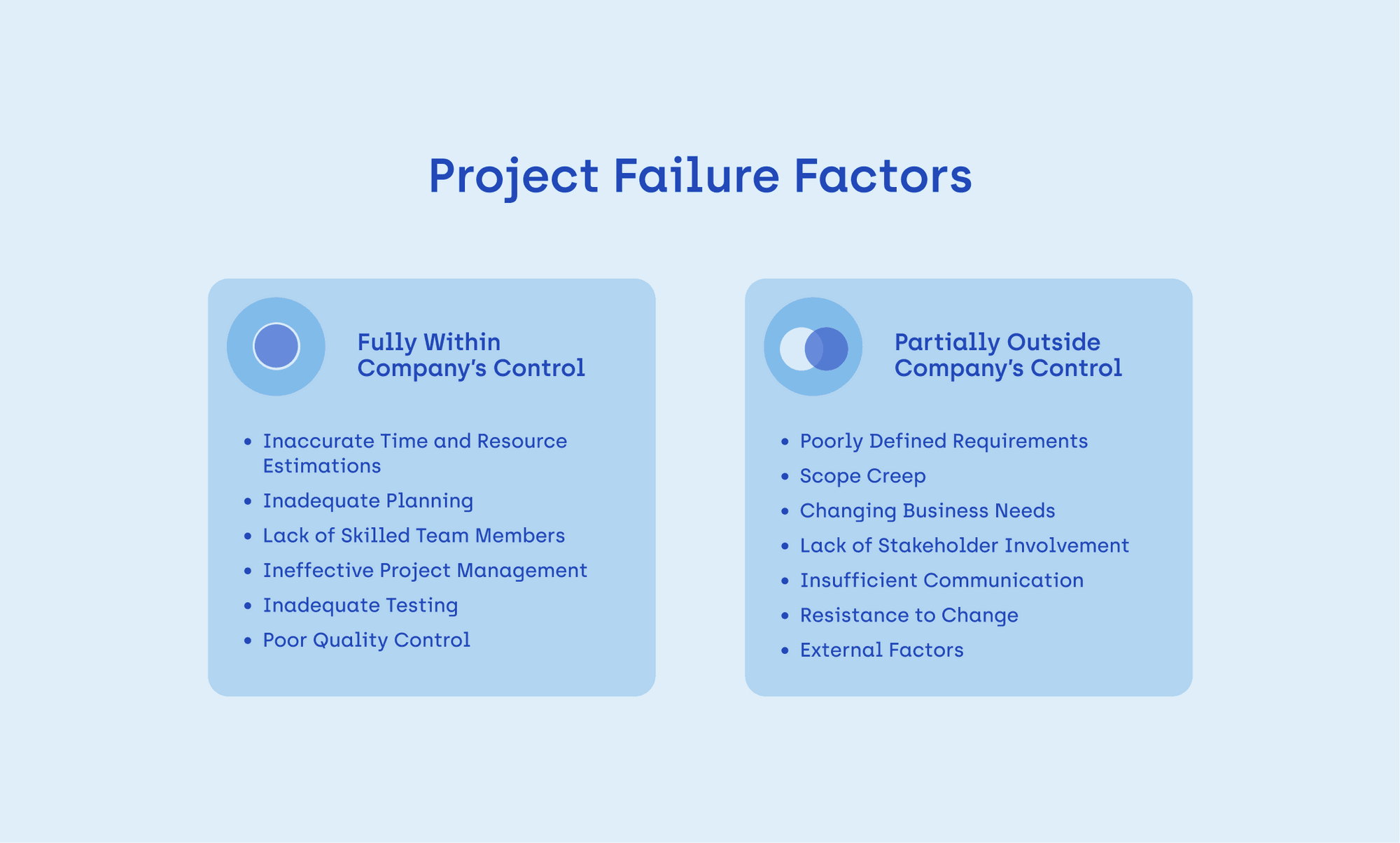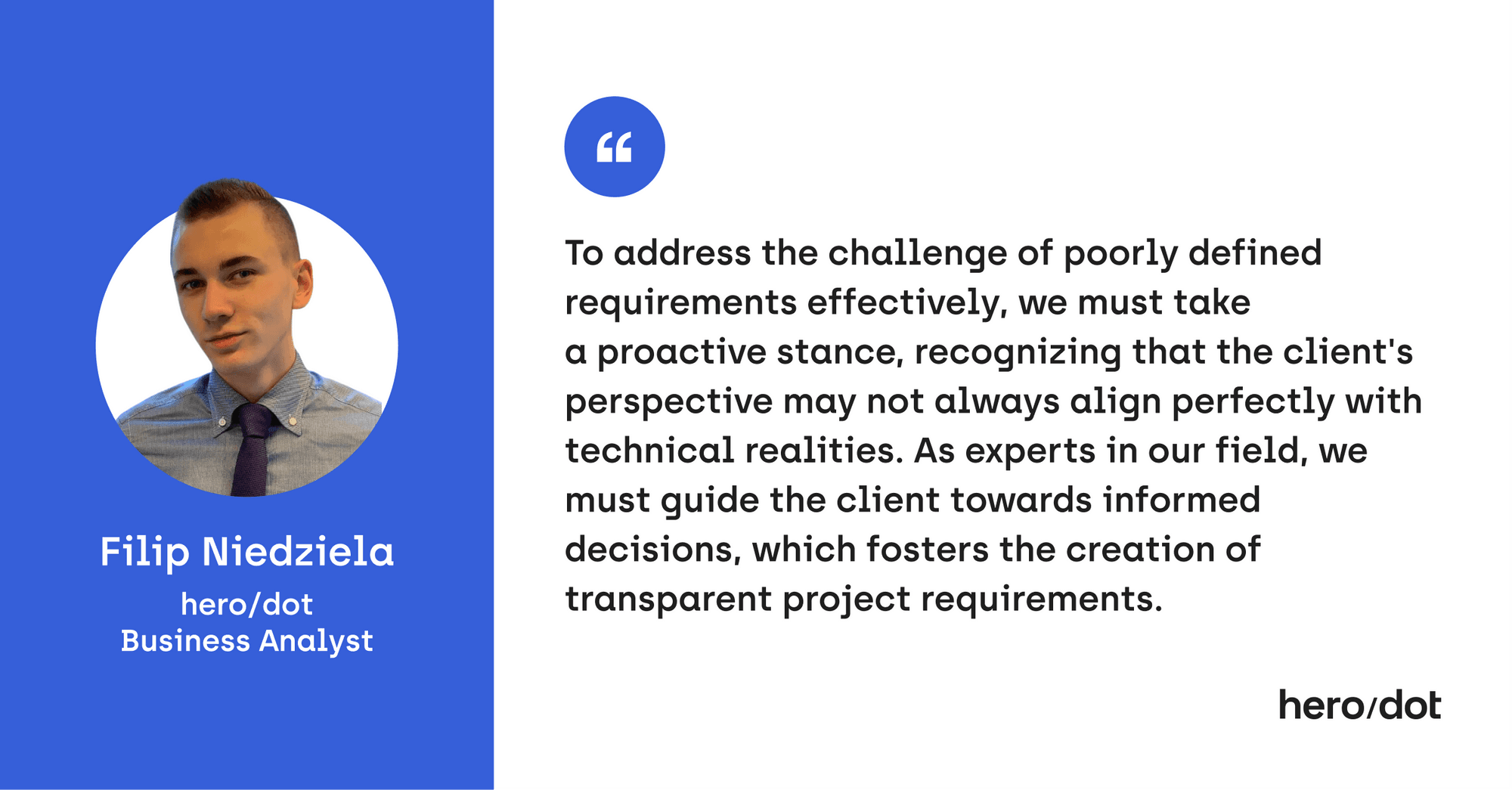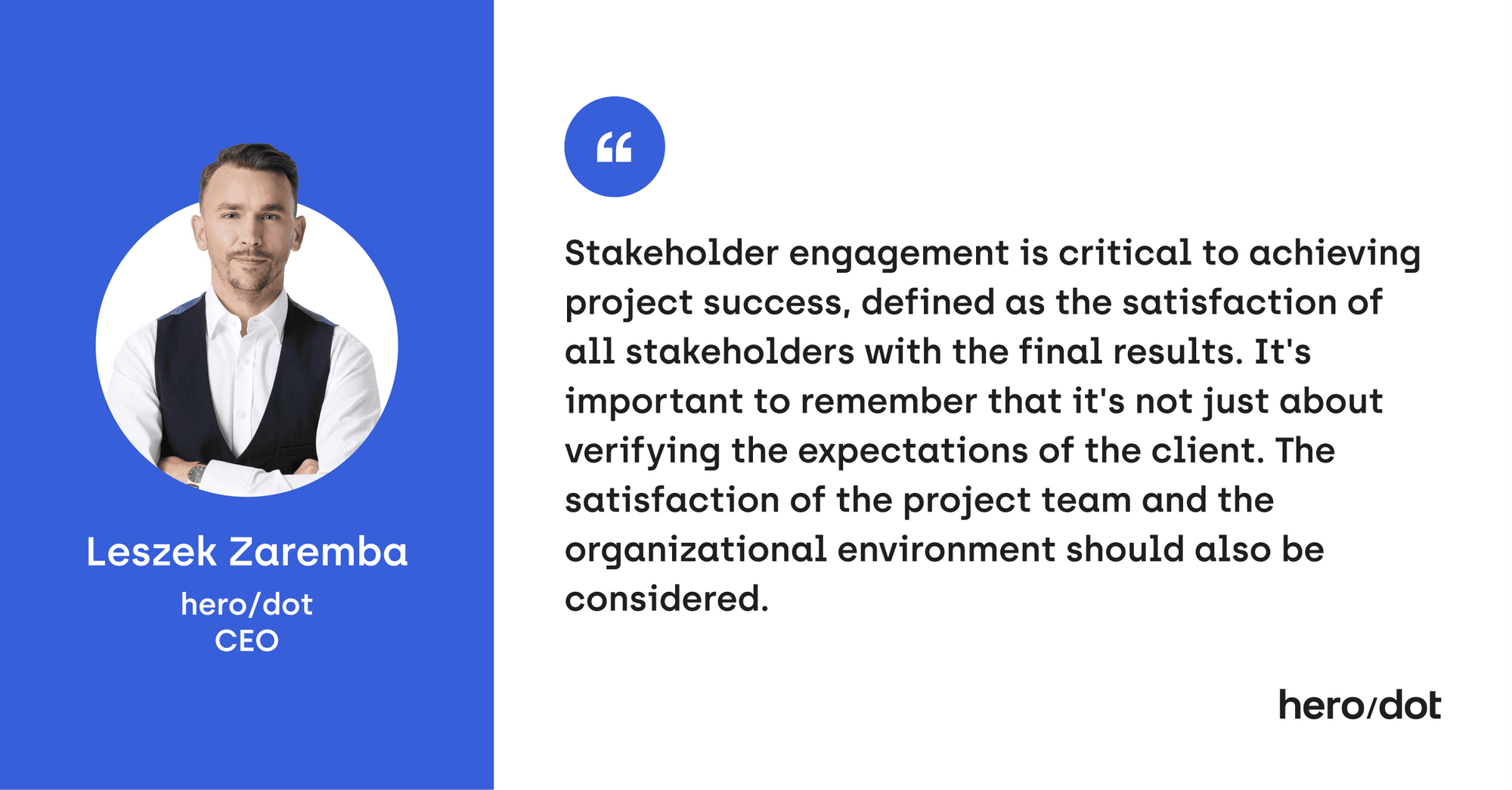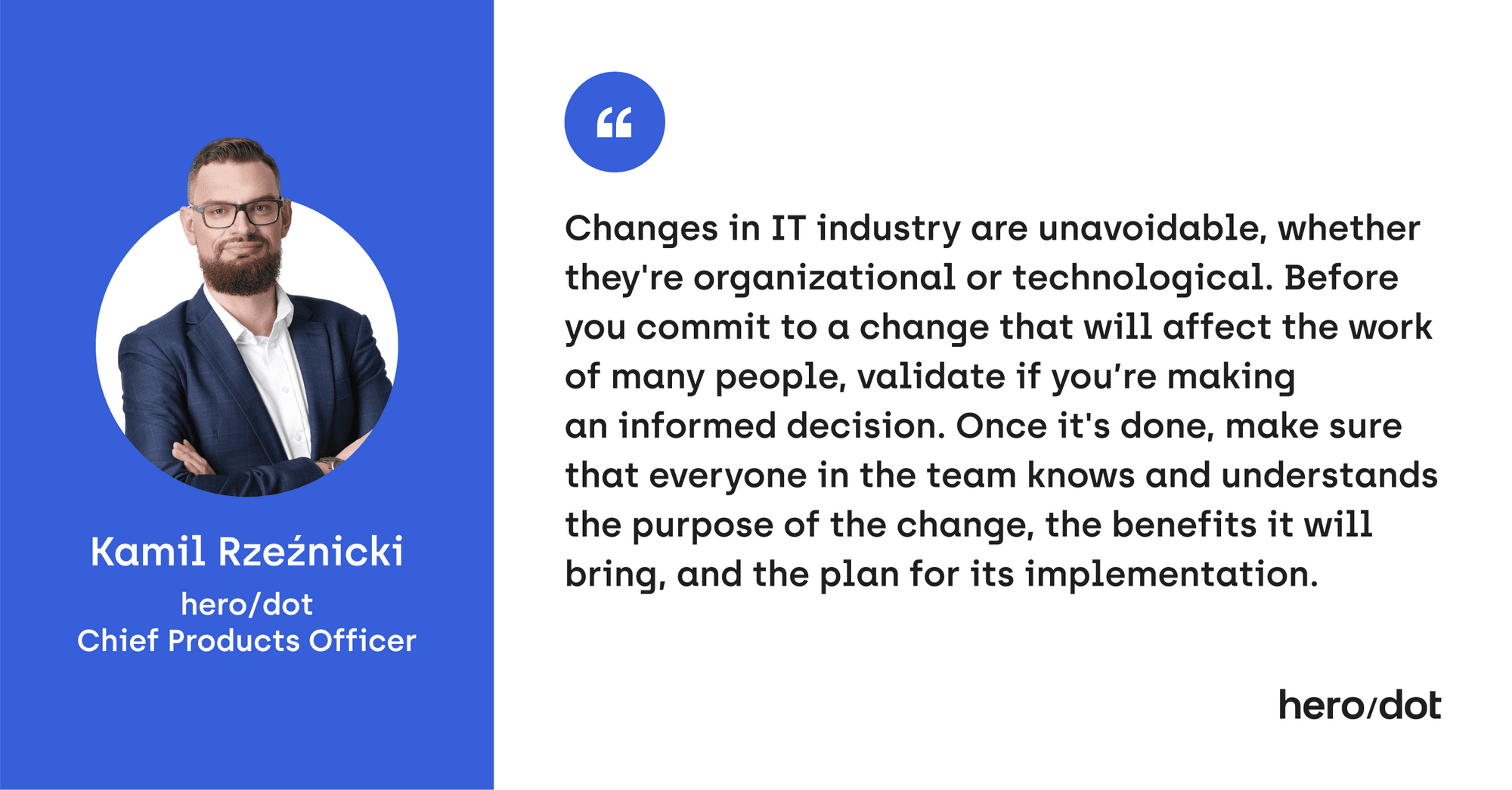13 Reasons Why IT Projects Fail
Anna Rózga

Success, a gleaming beacon on the distant horizon that sets the course for your IT project. However, blinded by the light, some software companies never reach the shores of victorious delivery, falling into common project pitfalls.
In this article, we will explore 13 reasons why projects fail, examining both internal factors within a company's control and external forces that lay outside it. Along the way, we will offer invaluable tips and words of advice from hero/dot's experts: Filip, Tomasz, Leszek, and Kamil. Whether you have some valid concerns about your upcoming project or currently face difficulties in an ongoing one, we're sure you'll find this article insightful.
Let's dive right into it!
Factors Within Company’s Control
When it comes to project failure in the IT industry, factors can broadly be divided into two categories: those fully within the software company's control and those partially outside it. Leading software houses excel in managing the former to guarantee that project failures become a non-issue. As a software agency with over a decade of experience, we recognize that project success rests on our ability to deliver on our commitments and avoid detrimental mistakes. Let's delve into factors within a company's control and share hero/dot's invaluable insights for eliminating them.

Reason #1: Inaccurate Time and Resource Estimations
As unnerving as it sounds, a detrimental mistake could happen before the project even begins. When setting the project budget and timeline, some software companies might:
- Fail to uncover unforeseen complexities in the project scope.
- Disregard historical data and expert judgment.
- Opt for overly optimistic estimates.
- Bypass the analysis stage altogether.
Underestimating the time and resources required to complete the project can lead to missed deadlines, major project delays, and cost overruns. As such, at hero/dot, we strongly believe that pre-implementation analysis is the cornerstone for software project success. This meticulous report reveals hidden requirements, dependencies, and potential challenges, laying the groundwork for accurate estimations and effective resource allocation.
Hero Tip #1: As work progresses, remember to adjust the estimates, accounting for newly emerged insights.

Reason #2: Inadequate Planning
You wouldn't embark on a long and difficult journey without a map, would you? That's precisely why, before the work even commences, a project manager is tasked with preparing the project plan. This comprehensive document encompasses defining the project's objectives, scope, resources, key milestones, timelines, and tasks. However, poor project planning on the project manager's side may result in:
- Missed deadlines and persistent delays.
- Inefficient resource allocation.
- Inadequate project scheduling and milestones.
- Unclear delineation of roles and responsibilities.
What's more, when the time and resource management plan lacks precision and foresight, potential risks can swiftly turn into major obstacles, ultimately culminating in project failure. Fortunately, we possess an antidote to avert this disastrous outcome – team involvement. When drawing a map, a project manager should seek input from their journey companions, including business analysts, tech leads, team members, and stakeholders.
Hero Tip #2: While planning is crucial, remain flexible to adapt to unforeseen changes and mitigate potential roadblocks.

Reason #3: Lack of Skilled Team Members
Let's not forget about the most invaluable resource of all: human resources. From the team leader to each one of the project team members, meticulously selecting the right team with adequate expertise is paramount for any successful project. Otherwise, a lack of skilled team members could inevitably trigger:
- Shortage of expertise.
- An unbalanced team composition.
- Ineffective collaboration, problem-solving, and knowledge transfer.
- Inadequate delegation of tasks that might end up being assigned to individuals ill-suited for them.
While noticeable skill gaps may hinder progress and lead to project failure, the right team composition is the foundation for timely delivery. Within a balanced and cohesive project team, each member contributes a unique set of expertise, experience, and perspective, positively influencing the project's quality.
Hero Tip #3: At hero/dot, a multidisciplinary approach is key. We've noticed that fostering collaboration among experts from various backgrounds leads to more comprehensive (and often creative) solutions.

Reason #4: Ineffective Project Management
Just as every ship needs a captain, an IT project requires a proficient project manager. It is the project manager's responsibility to provide structure, maintain control, and oversee the entire development process. Hence, weak project management practices may result in project drift. Here are just some of them that inexperienced project managers should avoid at all costs:
- Ambiguously defined project objectives, roles, and processes.
- Absence of proper monitoring, tracking, and control.
- Poor communication between team members.
- Diffusion of responsibility.
- Failure to promptly address issues.
The consequences of ineffective project management range from decreased productivity and missed deadlines to budget overruns and outright project failure. On the contrary, good project management ensures that everything is planned, executed, monitored, and delivered in a systematic and timely manner.
Hero Tip #4: Choosing the right project management methodology is a real game-changer. You can read here about hero/dot's hybrid approach called SPARK.

Reason #5: Inadequate Testing
While clients do have the option to opt out of testing services, we highly advise against that. Some individuals mistakenly think that if it costs extra, then it's not a vital part of the software development process. This misconception often leads to skipping or inadequate testing, which involves:
- Allocating insufficient time and resources for testing.
- Relying solely on manual testing without integrating automated tests.
- Overlooking security testing.
- Neglecting to simulate real-life scenarios and user behavior.
The challenge with testing is, as stated by one of the seven rules of testing, that exhaustive testing is impossible. There are simply far too many potential input combinations to check each one of them, which would also consume an unreasonable amount of time and budget. Nevertheless, what testing can guarantee, is that the released software meets acceptance criteria and eliminates critical errors that could jeopardize the software's functionality.
Hero Tip #5: Make sure that testers remain involved throughout the entire project lifecycle to proactively identify and resolve all potential issues before they snowball into costly and challenging problems.

Reason #6: Poor Quality Control
Not every failed project meets its doom before launch. Some manage to make it to the public eye, only to ultimately bring substantial financial losses by failing to meet user expectations. The root cause? Lackluster quality control practices, such as:
- Absence of well-defined standards and acceptance criteria.
- Neglecting inspections, audits, reviews, and feedback.
- Lack of continuous improvement processes.
Failing to implement proper quality assurance procedures can yield low-quality project deliverables that fall short in terms of usability and competitiveness on the market. The goal of quality assurance is to systematically pinpoint and address software issues during production. By fostering a culture of service quality and continuous improvement, software houses can confidently deliver products that meet industry standards and satisfy customer expectations.
Hero Tip #6: Simply adopting quality as a company value isn't going to cut it. A genuine culture of service quality must be embraced and practiced across all organizational levels.

Factors Partially Outside Company’s Control
As aforementioned, not all factors behind failed projects are under a software house's total control. Some, such as changing business needs, communication issues, or economic shifts, are influenced by external forces. However, rather than resigning to those circumstances, resilient software companies adapt mitigation strategies to minimize or eliminate risks. Let's learn about the most common factors outside a company's control and hero/dot's battle-tested tips for navigating unpredictability and delivering successful projects.
Reason #7: Poorly Defined Requirements
Just as puzzle pieces must fit together perfectly to form the complete picture, project requirements need to be assembled correctly to result in a cohesive and functional project. It's no wonder that the repercussions of relying on inadequate or unclear requirements can be daunting:
- Miscommunication that causes conflicts among stakeholders.
- Unrealistic expectations about the project goals and deliverables.
- Frequent shifts in direction that delay project progress.
- Incomplete or inadequate documentation.
- Scope creep (we'll delve into that later).
Comprehensive and clearly defined requirements serve as a blueprint for the entire development and implementation journey. They facilitate precise time estimation, effective resource allocation, and accurate task assignment. However, if neglected, the likelihood of misunderstandings, costly reworks, delays, and budget overruns skyrockets.
Hero Tip #7: Investing time and money into scrupulous pre-implementation analysis workshops is sure to pay off. You'd be astounded at the sheer number of functional requirements that might be overlooked even in the most thorough of RFPs (Request for Proposals).

Reason #8: Scope Creep
The term 'scope creep' refers to a phenomenon when functional requirements expand uncontrollably beyond the original objectives. Being one of the most common project pitfalls, it often goes hand in hand with:
- Strained resources.
- Extended timelines and postponed delivery.
- Unclear objectives, often accompanied by shifting focus towards non-essential features.
- An increase in complex tasks, which decreases team efficiency and causes bottlenecks.
Although scope creep is a challenge plaguing countless development teams, it doesn't have to lead to project failure. There are some tried-and-true strategies to counter it, including keeping detailed documentation of project goals and scope, fostering agile management practices, and holding regular client feedback sessions.
Hero Tip #8: At hero/dot, we combat scope creep head-on by implementing a change control process. This allows us to manage and assess proposed changes to a project's scope in a structured and systematic manner.

Reason #9: Changing Business Needs
Here goes one of the trickiest causes of project failure. Picture this: a company invests in a custom software solution. Suddenly, their organizational priorities do a 180, rendering the project misaligned with the company's new strategic goals. This poses significant challenges for project management in terms of:
- Lost momentum.
- Wasted resources.
- Diminished progress.
- Shifts in the project plan, schedule, and objectives.
- Managing stakeholder expectations.
Root causes of changing business needs range from evolving market trends and technological breakthroughs to internal restructuring or emerging opportunities. Nonetheless, project managers must realign their focus, reevaluate tasks, and propose solutions to accommodate new requirements. Otherwise, failing to address shifting priorities and proceeding with original objectives will probably result in wasted resources and an ROI written in red ink.
Hero Tip #9: Although certain aspects will remain beyond your control, fostering open communication with key stakeholders can help you take proactive measures when a shift in priorities occurs.

Reason #10: Lack of Stakeholder Involvement
Speaking of which, in most cases, it's the client who gets to determine their degree of involvement in the process. However, without their engagement throughout the development phases, the project may stumble into:
- Misalignment between project objectives and client needs.
- Client dissatisfaction caused by deliverables falling short of their expectations.
- Hindered decision-making, especially in emergency situations.
- Lack of feedback and iterative refinement processes.
Due to inadequate stakeholder management, stakeholders may feel overlooked, as if their needs and expectations are not being adequately addressed. To counter this, a software company should establish clear communication channels, arrange recurring feedback sessions, and send written meeting summaries to ensure everyone's on the same page.
Hero Tip #10: Right from the outset, express to your clients the immense value you place on their insights and perspectives. This lays the foundation for further cooperation.

Reason #11: Insufficient Communication
Despite being labeled as a 'soft skill', effective communication stands as a cornerstone of any project's success. Poor communication practices between stakeholders, team members, and project managers may jeopardize the overall outcome. Here are some of the most prevalent project fail scenarios:
- Project teams work isolated, resulting in duplicated efforts.
- Misunderstandings and conflict arise due to poor stakeholder management.
- Timelines, milestones, and status updates are not mutually exchanged, causing missed deadlines.
- Insufficient communication obstructs effective problem-solving and swift decision-making.
To prevent project failure, clear communication rules ought to be established right from the project's start. It's beneficial to leverage built-in communication channels to create spaces for sharing progress updates, feedback, and concerns. There are many project management tools available that streamline information exchange and make aligning efforts easier than ever.
Hero Tip #11: Take into consideration your recipient's style of communication. Consider whether they prefer formal or informal wording, sending emails or catching up on Slack.

Reason #12: Resistance to Change
If it works, why fix it, or so the saying goes. In reality, flexibility, and adaptability to changing business and technological landscape are core characteristics of thriving software companies. Enterprises that cling to a resistance-to-change mentality frequently struggle with:
- Loss of competitiveness due to falling behind technology.
- Team members reverting to old processes due to inadequate change management techniques.
- Failure to properly communicate the reasons behind the change to employees and stakeholders.
- Change fatigue, which leads to decreased productivity.
Employee resistance typically stems from fear of the unknown, loss of comfort, disruption in routines, or job security concerns. This can hinder the adoption of new processes, technologies, or methodologies essential to avoid project failure. To facilitate a smooth transition, project managers or leaders should involve team members in the process by addressing their concerns and offering training and support.
Hero Tip #12: Here's our approach to forward-thinking project management: software houses should view change as a necessity for survival in the market. To win over your employees and stakeholders, provide them with clear reasoning behind changes and the benefits they will bring.\

Reason #13: External Factors
Last but not least, let's explore project failure factors that lie completely beyond anyone's control, encompassing:
- Economic shifts and recessions.
- Unforeseen market changes.
- Technological breakthroughs.
- Geopolitical factors.
- New legislation and regulations.
- Natural disasters.
Those unforeseeable external factors can trigger budget constraints, resource shortages, timeline adjustments, and shifts in objectives, often resulting in costly reworks or even project termination. While challenging events remain outside the software company's control, smart risk management strategies empower organizations to face severe adversity head-on. This involves identifying potential threats early on, formulating a mitigation plan, and continuous monitoring of potential obstacles.
Hero Tip #13: Many external risk factors contain untapped potential for gaining a competitive edge. By seeking opportunities within every challenge, you might just discover the silver lining.

In conclusion
As we conclude this exploration of 13 reasons why software projects fail, it becomes clear that success in the IT world isn't merely the absence of failure but the result of expert risk management, meticulous planning, and effective communication. With this lesson in mind, we hope your project will not only survive in the changing business and technology landscape but thrive in it.
Are you in the process of researching software companies for your upcoming IT project? Contact us today! Thanks to hero/dot's commitment to excellence, we can turn every setback into a stepping stone to achieving project success!
Need expert assistance with your digital project?
You may also like

